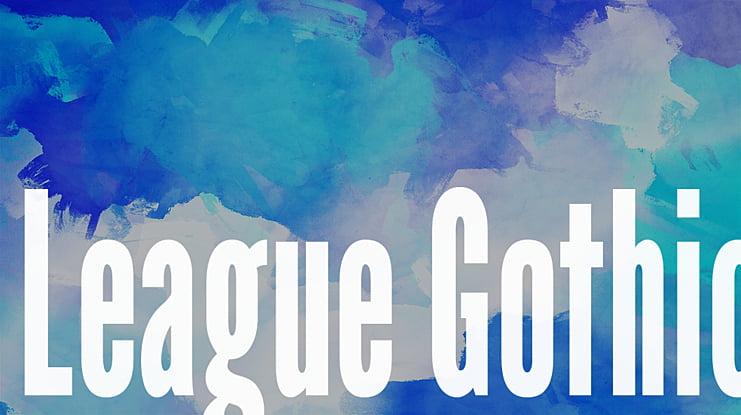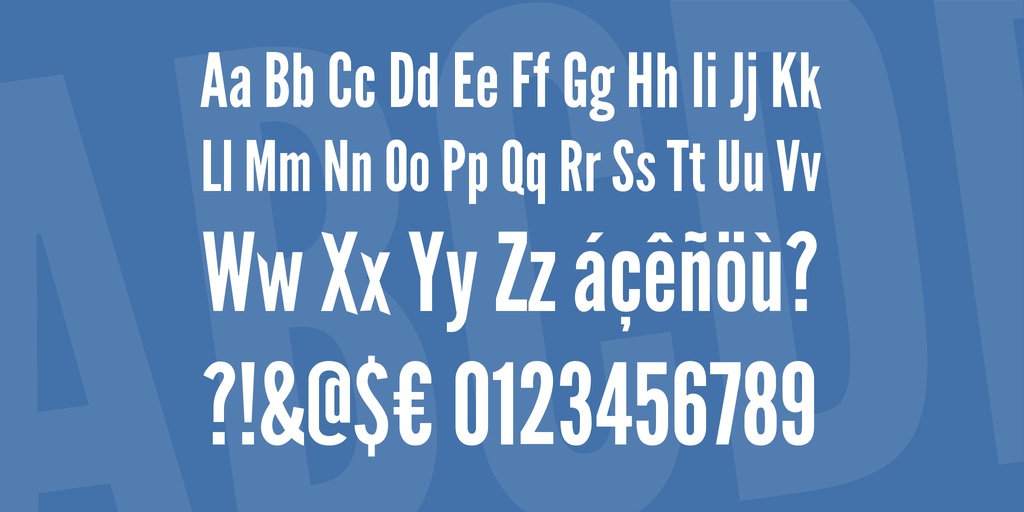
Gothic Condensed ( Linotype + Intertype + Ludlow)Īlternate Gothic was designed by Morris Fuller Benton for A.T.F. Libre Franklin is available on Google Fonts. The characters of this version are more expanded than many previous releases.Īn open source interpretation of Franklin Gothic has been made by Impallari Type as Libre Franklin. The American Type Founders Collection (ATF Collection unrelated to the original American Type Founders) has released a version named ATF Franklin Gothic. In ITC Franklin Gothic.the ear on the g keeps popping up like a schoolchild overly eager to answer a question." Calligrapher and design historian Paul Shaw argued that it was a failure for "mucking about with the distinctive Franklin Gothic g. While ITC Franklin Gothic is the most common release, it has been criticised for modifying the structure of the family considerably.
#LEAGUE GOTHIC WEBFONT WINDOWS#
Microsoft Windows has distributed "Franklin Gothic Medium," one of ITC's variants of the font, in all copies since at least Windows 95. Bitstream’s version is called Gothic 744. Victor Caruso drew a multi-weight family for the International Typeface Corporation (ITC) in 1979 and in 1991, ITC commissioned the Font Bureau in Boston to create condensed, compressed and extra compressed versions of ITC Franklin Gothic. Franklin Gothic - Alphatype, Autologic, Berthold, Dymo, Star/Photon, Mergenthaler, MGD Graphic Systems, Varityperĭigital copies have been made by Adobe, International Typeface Corporation, Monotype Imaging, and URW.Cold type copies ĭue to the post-war popularity of Gothic faces, most producers of cold type offered their own versions of Franklin Gothic. The Ludlow version was known as Square Gothic Heavy. Monotype’s copy kept the name Franklin Gothic, but because of the demands of mechanical composition, their version was modified to fit a standard arrangement. The tail of the Q curls down from the center of the letterform.īarnhart Brothers & Spindler copied the face as Gothic #1, while both Linotype and Intertype, called their copies Gothic #16. It can be distinguished from other sans serif typefaces by its more traditional double-storey a and especially g (double-storey gs, common in serif fonts, are rare in sans-serif fonts following German models, but were quite common in American and British designs of the period), the tail of the Q and the ear of the g. Franklin Gothic Condensed Italic (1967) designed by Whedon Davis.Franklin Gothic Wide (1952) designed by John L.Many years later, the foundry again expanded the line, adding two more variants: Franklin Gothic Condensed Shaded (1912).Franklin Gothic Condensed + Extra Condensed (1906).

The faces were issued over a period of ten years, all of which were designed by Benton and issued by A.T.F. It was named in honor of Benjamin Franklin, who was also a prolific printer. Historian Alexander Lawson speculated that Franklin Gothic was influenced by Berthold’s Akzidenz-Grotesk types but offered no evidence to support this theory which was later presented as fact by Philip Meggs and Rob Carter. It draws upon earlier, nineteenth century models from many of the twenty-three foundries consolidated into American Type Founders in 1892. History Ī guide explaining the names used by ATF for their many somewhat related 'gothic' types.įranklin Gothic itself is an extra-bold sans-serif type. It is in part bundled with Microsoft Windows.
#LEAGUE GOTHIC WEBFONT SERIES#
Probably the best-known extension of Franklin Gothic is Victor Caruso's 1970s ITC Franklin Gothic, which expands the series to include book weights similar to Benton's News Gothic in a high x-height 1970s style. Many versions and adaptations have been made since. Benton's Franklin Gothic family is a set of solid designs, particularly suitable for display and trade use such as headlines rather than for extended text.


Despite a period of eclipse in the 1930s, after the introduction of European faces like Kabel and Futura, they were re-discovered by American designers in the 1940s and have remained popular ever since. The typeface continues to maintain a high profile, appearing in a variety of media from books to billboards. “Gothic” was a contemporary term (now little-used except to describe period designs) meaning sans-serif.įranklin Gothic has been used in many advertisements and headlines in newspapers. Gothic #1, Square Gothic Heavy, Gothic #16įranklin Gothic and its related faces are a large family of sans-serif typefaces in the industrial or grotesque style developed in the early years of the 20th century by the type foundry American Type Founders (ATF) and credited to its head designer Morris Fuller Benton.


 0 kommentar(er)
0 kommentar(er)
